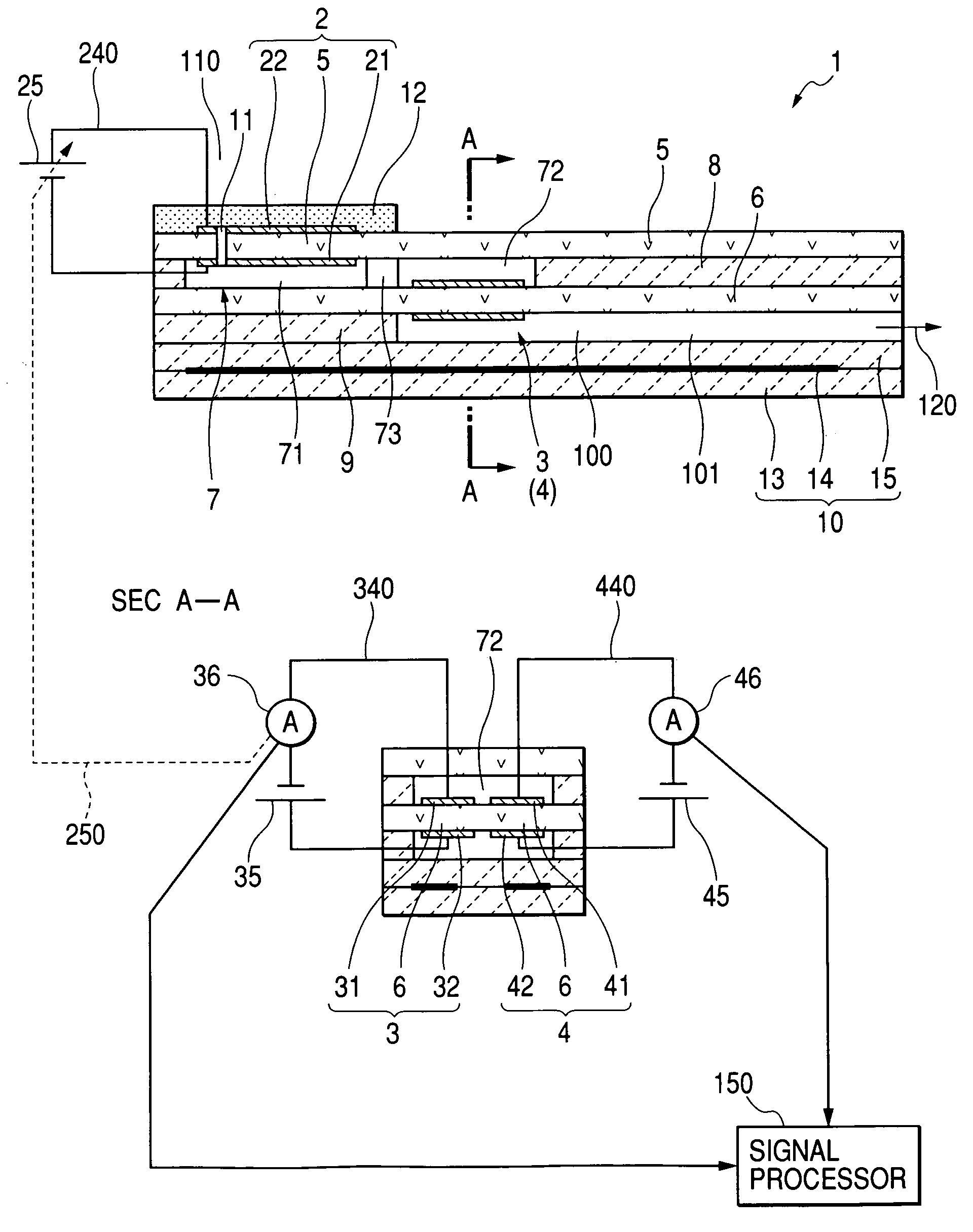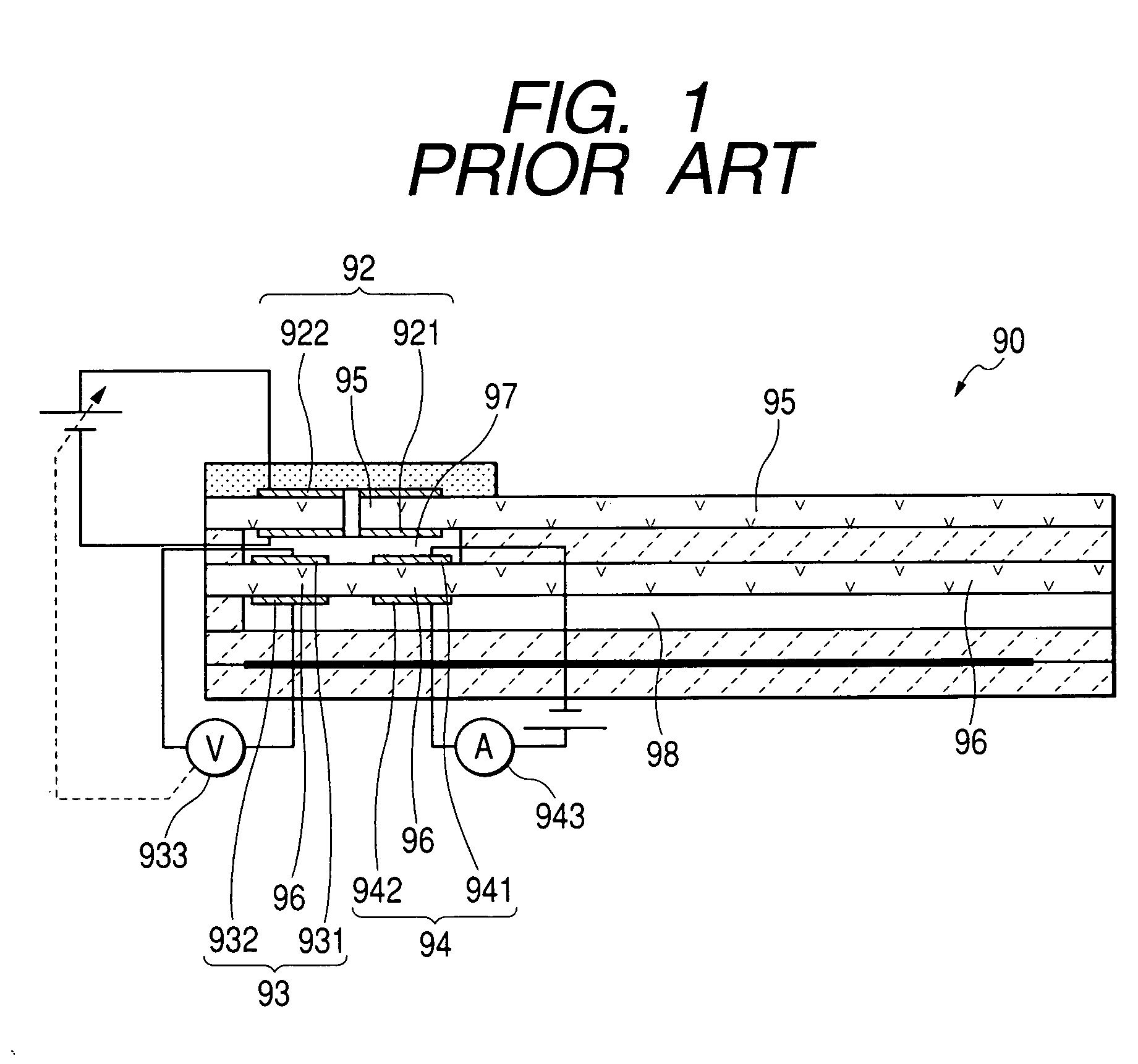Gas sensor and method of detecting gas concentration
a gas sensor and gas concentration technology, applied in the field of gas sensors, can solve problems such as errors in prior-art hydrocarbon gas sensors
- Summary
- Abstract
- Description
- Claims
- Application Information
AI Technical Summary
Benefits of technology
Problems solved by technology
Method used
Image
Examples
first specific embodiment
[0083]FIG. 2 shows a gas sensor 1 according to a first specific embodiment of this invention. The gas sensor 1 is designed to measure the concentration of hydrocarbon (HC) in a measurement gas such as an exhaust gas produced by an automotive engine. The detected HC concentration can be utilized in controlling the burning of an air-fuel mixture in the automotive engine.
[0084]As shown in FIG. 2, the gas sensor 1 includes a measurement gas chamber 7 into which a measurement gas (an exhaust gas) is introduced. The gas sensor 1 further includes an oxygen pumping cell 2, an oxygen monitor cell 3, and a sensor cell 4.
[0085]The oxygen pumping cell 2 has a solid electrolyte member 5 and a pair of electrodes 21 and 22. The electrodes 21 and 22 are provided on the lower and upper surfaces of the solid electrolyte member 5, respectively. The electrodes 21 and 22 are opposed to each other. The electrode 21 is exposed in the measurement gas chamber 7. The electrode 22 extends on an outer surface ...
second specific embodiment
[0137]A gas sensor 1 of a second specific embodiment of this invention is similar to that of the first specific embodiment thereof except for a design change mentioned hereafter.
[0138]In the gas sensor 1 of the second specific embodiment of this invention, the measurement-gas-side electrode 31 of the oxygen monitor cell 3 is active to hydrocarbon including methane (CH4). Specifically, the measurement-gas-side electrode 31 has a sufficient oxidizing activity with respect to hydrocarbon including methane (CH4). The hydrocarbon oxidizing activity of the measurement-gas-side electrode 41 in the sensor cell 4 is lower than that of the measurement-gas-side electrode 31 in the oxygen monitor cell 3.
[0139]Specifically, the measurement-gas-side electrode 31 in the oxygen monitor cell 3 includes a porous cermet electrode containing Pt (platinum). The electrode 31 is highly active to hydrocarbon including methane (CH4). In other words, the electrode 31 has a high oxidizing activity with respec...
third specific embodiment
[0144]FIG. 9 shows a gas sensor 1A according to a third specific embodiment of this invention. The gas sensor 1A is similar to the gas sensor 1 (FIG. 2) except for design changes mentioned hereafter.
[0145]As shown in FIG. 9, the gas sensor 1A includes a measurement gas chamber 7 into which a measurement gas (an exhaust gas) is introduced. The measurement gas chamber 7 is divided into a first measurement gas chamber 71 and a second measurement gas chamber 72 which communicate with each other. The gas sensor 1A further includes an oxygen pumping cell 2, an oxygen monitor cell 3, and a sensor cell 4.
[0146]The oxygen pumping cell 2 has a solid electrolyte member 6 and a pair of electrodes 21 and 22. The electrodes 21 and 22 are provided on the upper and lower surfaces of the solid electrolyte member 6, respectively. The electrode 21 is exposed in the first measurement gas chamber 71. The electrode 22 is exposed in a reference gas chamber 100 into which an atmosphere is introduced as a r...
PUM
| Property | Measurement | Unit |
|---|---|---|
| voltage | aaaaa | aaaaa |
| diffusion resistance | aaaaa | aaaaa |
| concentration | aaaaa | aaaaa |
Abstract
Description
Claims
Application Information
 Login to View More
Login to View More - R&D
- Intellectual Property
- Life Sciences
- Materials
- Tech Scout
- Unparalleled Data Quality
- Higher Quality Content
- 60% Fewer Hallucinations
Browse by: Latest US Patents, China's latest patents, Technical Efficacy Thesaurus, Application Domain, Technology Topic, Popular Technical Reports.
© 2025 PatSnap. All rights reserved.Legal|Privacy policy|Modern Slavery Act Transparency Statement|Sitemap|About US| Contact US: help@patsnap.com



